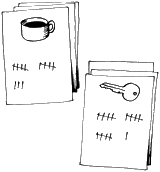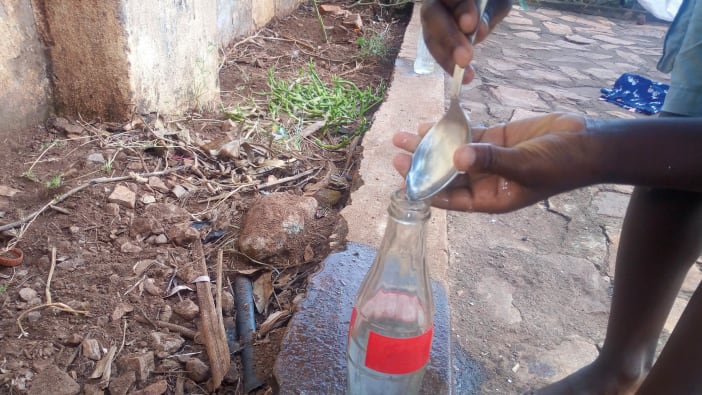How does it work?
1 Fifteen pictures (one for each candidate) of everyday items were chosen. These were easy to recognise and easy to draw. The pictures were drawn by hand. They included a cup, comb, key, lock, gourd ladle and dish.
2 A local craftsman was hired to make a rubber stamp with all the pictures on it (each picture a little larger than a thumbprint). Once completed, the stamp could be blotted onto an ink pad and pressed onto a half sheet of paper to produce a ballot. We used ordinary, inexpensive school notebooks and quickly produced enough ballots. The total cost for materials (rubber stamp, ink pads, notebooks) was less than $10.
3 The candidates were nominated and seconded by the community members in an open meeting. As each candidate came forward, they were given a picture to hold up.
4 We then had a short role play to demonstrate the voting process (see box on the opposite page).
5 Four bicycles were used as voting stations! An ink pad was placed on the bike rack, and the seat used as a surface to mark the ballot. Each person had a ballot paper and could vote for three candidates. They marked with a thumbprint the pictures that related to the three people they wished to serve on the committee. While people voted, the candidates sat nearby holding up their pictures, so the voters could make sure they selected the right picture.
6 Once the voter had put three thumbprints on the ballot, the ballot was put into a container. The candidates also voted, one at a time, while the rest of the candidates remained seated with their pictures in view.
7 Votes were then counted and recorded. A master page was made by stamping each small picture onto one page of paper with space to record counting marks. Two non-candidates, selected by the village chairperson, recorded all ballots. All candidates supervised the counting of the ballots. The marks were counted and the seven winners were announced.
This process was new and took some time to explain, but was very worthwhile. Even people unable to read and write were able to vote and take a full part in community work.
Advantages
- Everyone has an equal, confidential vote.
- Inked thumbs reduce the risk of repeat voters. People with ink on their thumbs would not be allowed to vote again.
- Bias is reduced in counting the votes, as only pictures, rather than people's names, are used.
- A thumbprint can only mark a picture once. Voters cannot make several votes for the same person.
Hints and tips
- Use simple, common household items for the pictures. Avoid items that could be seen as very negative or very positive. For example, pictures of things like a snake (which could be seen as evil) or money (which could mean a vote might be followed by a financial gift) were avoided.
- As a person is nominated (by voice) to be a candidate, give them a picture and write their name on the back.
- Set up enough voting stations so the process does not take too long. Bicycles worked well.
- As soon as voting is over, collect the pictures from the candidates before counting the results. Most of the people counting will quickly forget which candidates were represented by which picture and this helps prevent any bias in counting.
- Make sure everyone in the community has plenty of warning about the voting day.
Jonathan Anderson and Todd Rasmuson work with Mission Moving Mountains, PO Box 51, Bariadi, Tanzania.









